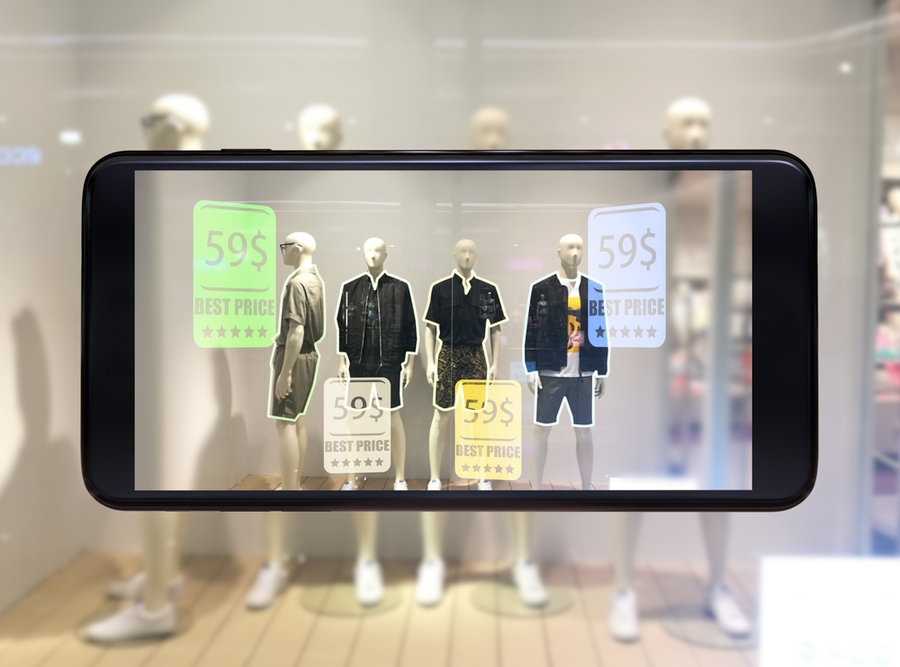What if you were walking through a home furnishing store and stumble upon something you need. You are worried if making the purchase is the ideal choice because a) What if it doesn’t fit into your nook? b) Will the color match the rest of your furniture? c) Will it make the room more crowded? Instead, what if you could get immediate answers to those questions by following the same process but the only difference - using your smartphone and staying at home. That’s how Augmented Reality (AR) is penetrating and obviously changing the market.
What is augmented reality? How is it making a difference?
Through the 90’s and early 2000’s, the two-dimensional television screen helped us physically experience instances that happened across the world. Augmented reality was once a cool feature that we read about or saw in movies. Now, it is revolutionizing the digital marketplace for many industries.
Augmented reality is the integration of digital information within the user’s existing environment in real-time. Smartphones combined with AR technology have brought customers into the era of next-gen experience and engagement.
Unlike virtual reality, AR superimposes new information and showcases an enhanced version of the current setting. Over the past few years, businesses have realized that AR offers more practical applications for CX. It is redefining the essence of customer satisfaction by creating gripping interfaces that cannot be ignored. Therefore, with the likes of Pokémon Go, Snapchat, Instagram and others, augmented reality is playing a pivotal strategy in the art of customer experience.
Is augmented reality disrupting customer experience (CX)?
The average millennial buyer is immune to mass-generated services or promotions. They are on the lookout for personalized experiences that appeal to their varying needs every time. Furthermore, augmented reality is a game-changer and is transforming the way businesses engage with customers. It can boost the power of CX when combined with other technologies, thus making it useful for many departments across different industries. And there are three reasons why it is making its way into every business’ strategy:
- Emotional connection:Whether it’s product or an experience, it is natural to form an emotional bond. AR technology can do the same by changing the way you feel and garnering the same emotions
- Access to information: Training and learning have become easier with AR. With readily available, easy-to-understand information, it promotes multi-sensory learning
- Creates imaginary environments: It helps users experience multiple scenarios in real-time and without developing prototypes. This leads to an increase in the number of potential buyers

Augmented reality in the customer journey
Analytics plays a big role in every customer journey, but there are value additions that AR can make to elevate CX.
Pre-Sale: The Analysis Phase
Decisions take shape here. As customers have instant access to information, there are very few impulse decisions taken. This is because they are well-researched since they want the best. And augmented reality makes this process easy.
a) No more apprehensive thoughts: E-commerce sites have made shopping simple, but questions about products are often unanswered until delivery. With augmented reality, customers can breathe a sigh of relief as interactive apps remove the uncertainty. It helps to modify the customer’s surrounding into virtual showrooms using visual aids overlaid on smartphones. For example, Ikea’s Place app allows customers to place furniture at their homes in full-scale before making a purchase.
b) Interactive advertising and packaging: AR has a higher advantage over other advertising forms. It is active, useful and involves the customer with the power of suggestion through experiential marketing. For example, brands are creating interactive visual experiences using packaging. Nesquik offers engaging games that can be played by pointing the smartphone at the packaging.

Sale: The Point of Purchase Phase
At this stage, customers have taken the decision to make a purchase but need a little extra validation. Augmented reality is frequently used in this phase and has really paved the way to drive sales.
a) Try before you buy: Can’t find the right shade of teal for a shirt? Scared to try a new hairstyle? AR-based apps let users take a virtual trial before making a commitment. It takes the guesswork out of choosing what works and what doesn’t. For example, The Dressing Room by Gap allows customers to select a garment from the virtual shelf. An AR-generated model having a similar body shape, tries the clothing. It can be rotated 360⁰ to give the shopper a better angle of the outfit.
b) Improve buyer experience: Augmented reality – it’s convenient and making the retail experience simpler. For instance, Samsung Mall allows users to shop using their phone camera. They just point, scan a product and hit search. Once complete, it displays the product information along with other similar products. Friends with Holograms is also building AR tools with the same functionality.
Post-Sale: The Support Phase
Should the experience stop after the purchase? It shouldn’t, and many businesses in the past seemed to have gone astray. Now, they are on the right path of upping their post-sales service as augmented reality has made this service seamless.
a) User manuals and self-service: Say goodbye to bulky manuals. In the digital age, even 300-page documents are being given an uplift. Automobile brands like Hyundai have developed AR-based digital manuals. With a smartphone, users can understand the parts and workings of the car, such as what the switches can do, or how to change a tire or check oil levels.
b) Technical support: The miscommunication between agents and customers sometimes costs the brand their loyalists. With a powerful AR-based visual aid, this problem can be avoided. For instance, with visual support, users just need to hold a product to the smartphone camera and all parts are identified in real-time. Agents can then identify the model number of the device, leading to faster resolution times.
What is the future of augmented reality?
AR blurs the line between what is real and computer-generated by simulating what we experience and feel. Now, everything with AR is associated with a smartphone. But will it evolve beyond the world of screens? Is it really the next big thing in customer experience?
Some sources claim that in the next five to ten years, there will be a new set of interfaces that AR will offer. Thus, early adopters of this technology will have a better insight as they will be able to develop and change the way customer engagement happens. But in a world where personalization is most sought after, will billboards turn into blank canvases that can be altered for every customer’s needs?
- Categories
- Tags
- Archives
Subscribe For Updates
Get the Servion Blog updates in your inbox.











